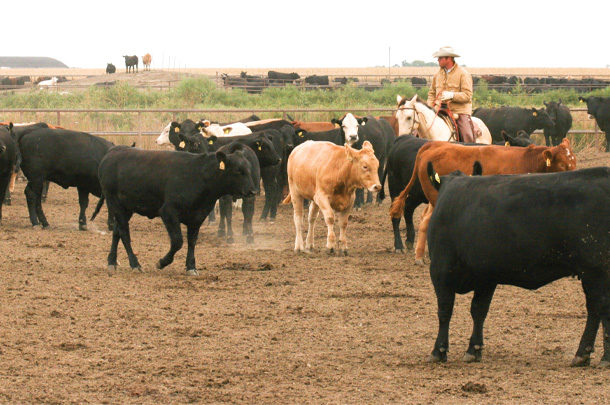“If a horse isn’t safe and bombproof, he doesn’t stay at our house,” says horsewoman, wife and mother of four Korrina Tomes-Hughes. When Korrina acquired a “witchy” horse who often squealed and kicked out, she quickly told her husband they had one year to solve her behavioral issues or she was “out of here.” Considering “a 1,200-pound horse versus our littlest kid of 40 pounds,” there can be no taking chances when it comes to safety.
Could the mare’s demeanor possibly be more than that of a “moody” or “mare-ish” mare?
It is important to bring up any behavior-related issues with your veterinarian, so they can examine your horse for any potential pain and discomfort that may be directing the behavior you’re seeing. And that’s just what this family did.
Pinpointing the problem
To diagnose the issue, Korrina’s veterinarian examined the mare, Cash Flip Seven, and soon discovered the mare’s estrus cycle was to blame for her, at times, poor behavior. “When she cycles, she cycles hard. It’s painful for her,” says Korrina. She was acting up because of the pain she experienced from estrus, which is common, according to a study conducted by University of Pennsylvania School of Veterinary Medicine. The study noted several poor behaviors directly linked to overall physical discomfort, which can often be overlooked and quickly labeled as “mare-ish.” Horsemen are likely familiar with the behaviors, which include:
- Animated bucking
- Kicking out
- Kicking walls
- Backing into or rubbing the hindquarters into walls or objects
- Self-biting
- Pawing (other than in anticipation of feeding)
- Frequent frustration head shaking
Finding a solution
Korrina’s veterinarian recommended two options: spay her or take her out of heat. That’s when they made the decision to put the mare on an altrenogest, which can suppress a mare’s estrus (heat) cycle, reducing undesirable changes in a horse’s behavior and mood. Within three days of the start of treatment, it can effectively suppress estrus in up to 95% of mares.
Korrina says it “has made a world of difference with keeping her out of heat. She backs in the box easier and doesn’t have ‘box sweat’ or any gate issues. She doesn’t balk at any of this stuff; she goes in and does her job like there is no tomorrow.”
Cash Flip Seven is now the family’s all-around horse, especially when it comes to team roping and barrels. “She’s won a lot in the roping world; everybody loves to rope on her. And she’s that horse who won’t hit a barrel and will make the same run every time for you,” she says.
An altrenogest requires a prescription from a veterinarian. Arnold Nagely, DVM, co-founder of Valley Vet Supply, has also heard success stories from horse owners who incorporate calming supplements into their horse’s daily regimen.
“Calming supplements include specific herbs, vitamins and minerals that can modify the neurotransmitters in the brain, changing the horse’s reaction to stress-inducing environmental factors,” says Dr. Nagely. “Magnesium plays an important role in the nervous and muscular systems. An adequate level of magnesium helps with stress management, muscle tension and irritable, unpredictable behavior, which is commonly experienced with the dropping temperatures much of us are beginning to feel. Vitamin B complex also is important in various metabolic functions within the body and is proven to help relieve anxiety and stress.”
There are a number of equine calming supplements available that can help manage your horse’s apprehension. Conduct your own research and be choosy, as not all supplements are formulated of the same quality. Many may be packed with sugars and fillers.
Resources for horse owners
To help address the under-recognized signs of pain in horses, co-authoring Drs. Catherine Torcivia and Sue McDonnell, within the University of Pennsylvania School of Veterinary Medicine, published “Equine Discomfort Ethogram,” an incredibly detailed catalog of behaviors associated with equine physical discomfort.
Torcivia and McDonnell outlined 73 specific discomfort behaviors and grouped them into eight categories: posture and weight-bearing; limb and body movements; head, neck, mouth and lip movements; attention to area; ear and tail movements; overall demeanor; altered eating or drinking; and vocalizations/audible sounds. Interestingly, the report states that “Recognition of discomfort in a prey species is particularly challenging. Horses have evolved to show little evidence of discomfort or disability in the presence of predators, including humans.”
Their published work includes illustrations, written descriptions and even videos to demonstrate each pain-induced behavior. It is a treasure for horse owners and horse health providers alike, and is deserving of a thorough read.
You know your horse better than anyone else, often seeing them daily. Watch carefully for any new behaviors, and ask yourself whether these behaviors could instead be the result of pain. Work closely with your veterinarian for diagnosis and management of your horse’s pain and discomfort. There are a number of medications available to help them.
Advice to others
Korrina encourages other horse owners not to give up on a horse too soon. “First, make sure your horse is not hurting and in pain. So often, people try to fix a horse’s attitude before fixing pain. Some are quick to write them off, but every person has their bad days, and horses do too. You can’t just write them off for a bad day or even a bad week. And when you have a mare, you especially have to make sure she is comfortable.”
If your horse is showing signs of discomfort that may be connected to heat, arthritis or other, contact your veterinarian to request an examination of your horse, and talk with them about your horse’s specific behavior. During your horse’s thorough examination with your veterinarian, speak with your veterinarian to learn more about the medications and supplements available to help ensure your horse lives their happiest, healthiest and most comfortable life possible, for more enjoyable rides and work with you on the ranch.







